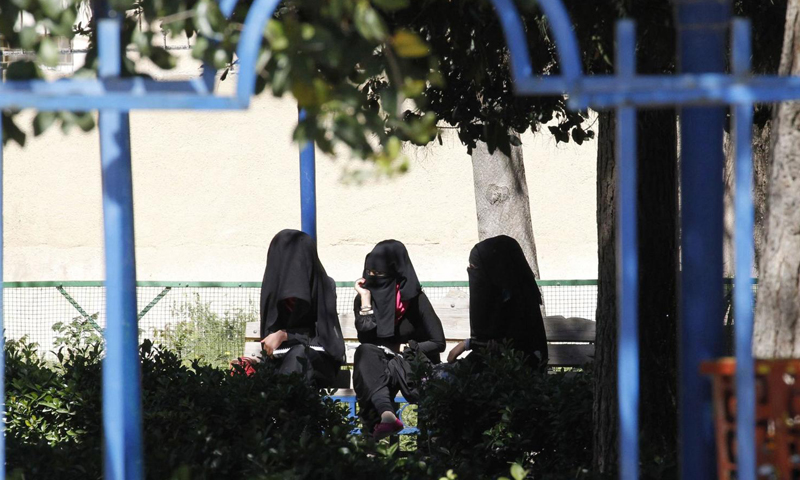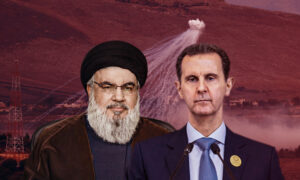Printed Edition ‖ No.: 221
Enab Baladi – Al-Raqqa
An Iraqi from Mountain Sinjar says with tears in his eyes; ”shame live among us”, wondering, “What did we do that our women are taken as slaves?”. That was a scene from a report broadcasted by the BBC after the withdrawal of the” Islamic state “from Sinjar last November; those phrases are repeated from his peers, wondering about the fate of the women and children of the Yazidi community who are now captives “slaves” to ISIS within its control zones in both Iraq and Syria.
The report presents the aspects of the life of the “captives” within the city of Al-Raqqa, the main stronghold of the organization in Syria, while opinions vary among those spoken to by Enab Baladi between supporters to the situation and those who oppose it, considering it as “the shame which covers the face of the twenty-first century.”
Civil refusal and attempts to rescue
Um Mohammed (a fictitious name) a nurse working in one of Al-Raqqa’s hospitals says, her neighbor in Al-Thakana neighborhood within the city, has two “captives”: The first is 19 years of age, and the second girl is only 13 years old.
Um Mohammed once examined the two girls when the young child was about to die due to severe bleeding caused by severe beating, according to the nurse, who explained that the girl died two days later, after her “owner” refused to provide her with medical care in the hospital “because she is infidel and a liar,” asserting ” the child died and no one knew about her fate.”
Um Mohammed adds to Enab Baladi “every day we would hear the voices of the two girls screaming out of beating and torture, without being able to help them out of fear of their owner, who works in the Islamic police of ISIS, also known for his sharp temper and bad morals,” arguing that what is happening is “bondage and slavery and a disgraceful act that neither human nor God will accept.”
The nurse confirmed the sympathy of local Syrians with the Yazidi prisoners, noting that they consider them “victims of an unacceptable barbaric acts unfamiliar to Syrians, these acts entered their city by the Iraqi immigrant elements and due to the expansion of the organization in the region.”
Um Mohammed pointed out that the people of Al-Raqqa “helped dozens of captives to escape, and some of the wealthy residents liberated some of the girls after buying them from ISIS members,” noting that it “has angered ISIS members, therefore, some people were questioned and accused of dealing with foreign parties, while others also received harsh penalties.”
Until this moment some people are still trying to help those captives in different ways, according to the civilians’ views surveyed by Enab Baladi in the city. They consider that they are at least helping, “in detecting their fate and giving their families news about them.”
Supportive views as “captivity is an application of the law of Allah”
The views on the “captivity” policy which is pursued by the organization are varied, but there are supporters of this policy “fatwa”, emphasizing its religious reference and historical roots, including Abu Maaz (a fictitious name), one of the displaced from Sokhna town in Al-Raqqa, he described to Enab Baladi that what is happening is “the application of the law of Allah.”
The young man believes that “a lot of schemes were put on the story of the captives as part of the war waged by the international community against the organization, faking stories to discredit its members,” considering that the members “are treating the captives as commanded by Allah, not hurting them but rather teaching them the rituals of praying and fasting.”
Abu Maaz talked about the prices of the “captives” and explained that it “varies according to their qualities, so it might be a few dollars or it could exceed a thousand dollars,” referring to it as “an individual price agreed upon by the seller and the buyer, and that they might be given as a gift,” but he denied the existence of a slave market within the city of Al-Raqqa, although he supports the idea…
The psychological impact on the “captives”
“The biggest shame over the face of the new century,” is a description by the psychological counselor Hassan Al-Ali, who works in one of the Syrian schools in the Turkish City Urfa. He said to Enab Baladi that he had heard dozens of cases of girls who have been able to escape the grip of the organization, “all of them have been subjected to violence and repeated rape” adding, “many of them are trying to escape, so they distort themselves or commit suicide in order to seek salvation in case they failed to escape.”
Al-Ali considers what is happening to contradict the most basic humanitarian standards and moral values, while various medical sources confirmed to Enab Baladi that many of the captives get pregnant and have abortions because of the daily sexual practices and violence against them. They are also forced to convert to Islam and perform acts of worship.
Although there are no exact figures for the number of “captives” at the organization, but most of the sources who spoke to Enab Baladi confirmed that the number of Yazidi women in Syria does not exceed 300 of different ages, distributed between the cities of Al-Raqqa and Deir Ez-Zour; among them are children under the age of 13, some of whom became pregnant and gave birth during the period of their presence at the organization.
Only a few of these girls were able to escape, during the first months of being in Syria, being helped by the people when the control was less than it is right now. Sources pointed out that ISIS currently prevents women to go out unless they have a special permission, what makes their flee almost an impossible task.
Wael al-Ali, a Syrian Kurdish activist in the Syrian Al-Jazeera, who is interested in human rights, wonders about the feelings of the captured girls’ families, saying “they must have families and brothers trying to get any information about their fate.”
The Kurdish activist spoke to Enab Baladi about the story of Lamia (19 years old); she is a Yazidi who was able to flee from the hand of ISIS nine months earlier, but she stumbled over a mine that exploded, taking away her sight. According to him, losing her sight “was not a reason for her to lose her love of freedom and the desire of redemption from slavery “hoping” the salvation for all prisoners enslaved by ISIS organization.”
Many new Yazidi’s stories unfold daily, who have been abducted by ISIS organization, and transferred from Sinjar Mountains and Ba’shiqah in Iraq to different parts of Syria and Iraq. Statistics of the international human rights organizations are talking about massacres carried out by ISIS organization against the Yazidis, as more than 24 mass graves have been found, the largest one being in Kojo village in northern Iraq, killing more than 700 men, while more than 800 women and girls were taken into captive.
Amnesty International: Yazidi women are committing suicide
Amnesty International stated in December 2014, that Yazidi women are committing suicide, after being captivated by the hands of the “Islamic state”, as a result of their domination over the religious minority areas in Iraq.
The Yazidi minority sons were subjected to an “extermination” process, according to the United Nations, committed by members of the extremist organization that have controlled the Yazidi areas in northern Iraq, including the killing of hundreds and taking “captives.”
Amnesty International’s Senior Crisis Response Adviser Donatella Rovera, in a report to Amnesty International said that “many who have been victims of sexual enslavement are aged 14 years old or 15, and even younger than that.”
What is the Yazidi?
Yazidi is one of the smallest religious minorities in Iraq and Syria. The number of Yazidi adherents around the world is estimated at 250 thousand, nearly 50% of them are centered in the northeastern city of Mosul and in Sinjar Mountain west of Mosul, Iraq.
This religion is described as a syncretism, incorporating ancient Zoroastrian Iranian elements with Christian, Jewish and Islamic traditions.
Despite the similarity in a number of traditions with other religions, yet it is considered to be an independent self-contained religion. Yazidis themselves try to place their belief in an era prior to Islam. This religion is called “the Yezidi religion” or “Dasin.”
The suffering that the Yazidis were exposed to in Iraq in August 2014, is one of the reasons stated by the United States to form the international coalition to launch strikes against ISIS sites in Syria and Iraq.
if you think the article contain wrong information or you have additional details Send Correction
النسخة العربية من المقال
-
Follow us :
Most viewed
- Syrians pack their bags in Turkey
- After Turkey and the opposition, SDF shows willingness to dialogue with Syrian regime
- After al-Hasakah, AANES releases prisoners in Raqqa
- After Baraa Qaterji’s elimination, Is Syrian regime replacing its economic façade?
- Syrian pressures prevent Omar al-Aroub from attending Paris Olympics


















 A
A
A
A
A
A








 More In-Depth
More In-Depth